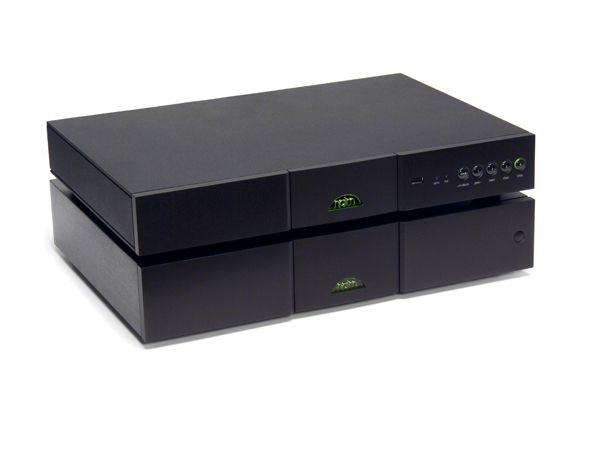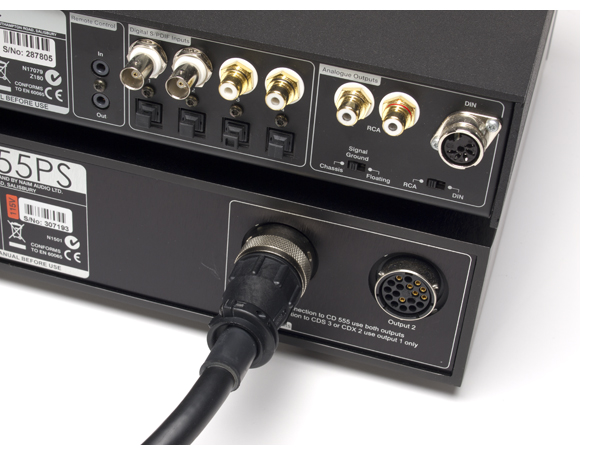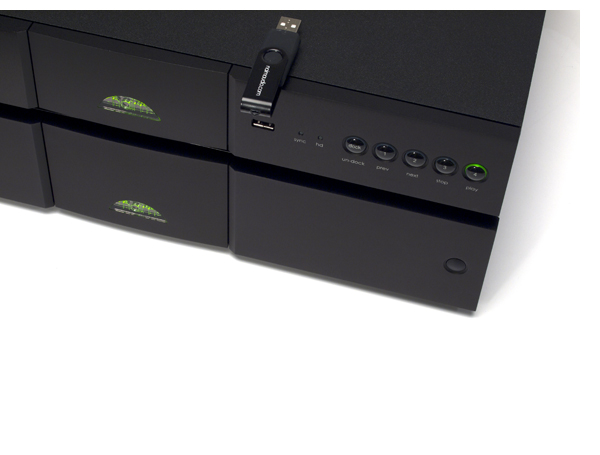Naim DAC and PS555 Power Supply Big Digital Building Blocks
By Earle Blanton and Jeff Dorgay With the race on to build bigger, better, more powerful gear, Naim has entered the field with its first standalone DAC. In the past, the company took a closed-architecture approach to digital, with its players claiming neither a digital input nor output. One uses them the way they come from the factory; the only available upgrade is a larger power supply.
With the race on to build bigger, better, more powerful gear, Naim has entered the field with its first standalone DAC. In the past, the company took a closed-architecture approach to digital, with its players claiming neither a digital input nor output. One uses them the way they come from the factory; the only available upgrade is a larger power supply.
If you aren’t familiar with Naim, it certainly follows a different approach than other manufacturers. In the case of its $3,695 world-class DAC, performance upgrades come in the form of more robust, external power supplies. This strategy (also used with its SuperLine phonostage) works well in the sense that you buy the DAC once, getting digital decoding ability along with a top-range product’s input and output flexibility—and the same tonality—for a reasonable price.
When more performance is needed, an external power supply is easily added. Enter the $5,595 XPS and $9,345 555PS. While the uninitiated might pause at the concept of an external power supply costing more than an actual component, we’ve been to this dance with Naim before, and the proof is in the listening.
The Naim DAC provides a great digital experience in standard form, but if you can make the jump, opt for the PS555. Like every other Naim component into which we’ve plugged a massive power supply, it makes for a stunning experience. Once you hear it, you will never go back. For those that keep gear for long periods of time, it’s reassuring to buy the DAC and know the job is done. When you get the itch to upgrade, adding a power supply is a simple task.
Regardless of output or file resolution, the Naim DAC plays flawlessly with every digital source we throw at it. No matter your digital arsenal, the user-friendly nit will improve its sound While Naim would, of course, like to see you purchase one of its music servers, if you have someone else’s server in your system, integrating the Naim DAC with a current setup shouldn’t be an issue. In addition to the Naim HDX, we used the QSonix, Meridian Sooloos, Aurender, and Squeezebox servers with all file resolutions without a glitch.
The DAC proves equally compatible with a wide range of transports. The MSB universal transport works particularly well with the Naim DAC, allowing audiophiles invested in physical media of all types—SACD, DVD-Audio, or even Blu-ray—to play their files from one source.
 Different Approach, Similar Sound
Different Approach, Similar Sound
Even though the Naim DAC takes an alternative modus operandi to the digital decoding process, the company’s CD555 uses old-school, 16 bit/44.1k architecture. The Naim DAC upsamples incoming data to 768khz, using a SHARC 40-bit floating point processor, which also handles the digital filtering. Audio data is then dumped into a RAM buffer before going to the actual DAC chips for D/A conversion. For a more in-depth overview of this process, download the Naim white paper here:
http://www.naimaudio.com/sites/default/files/products/downloads/files/dac_white-paper_issue3.pdf
Such methodology is not necessary with the CD555 because it only plays 16 bit/44.1khz files from CD; remember, however, the Naim DAC is compatible with all high-resolution digital formats. Credit Naim’s engineering staff for making the DAC/PS555 combination sound nearly identical to the CD555. Under the hood, the models couldn’t be more different.
The Naim DAC employs a plethora of inputs: a pair of RCA SPDIF, a pair of 75-ohm BNC inputs, and four toslink inputs. A USB port rests on the back and front panels; however, these inputs are not intended for direct connection to a computer. And forget about balanced XLR/EBU or FireWire inputs. Naim believes that a computer via USB doesn’t constitute an optimal way to transfer data to its DAC, so the USB input is for an external drive or memory stick. We found this handy when a friend brought over a few albums for a listening session.
Since the DAC is Apple compliant, you can use an iPod, iPhone, or iPad to stream music (up to 48kHz sampling rate) without the need for an external high-performance dock. Merely connect your iPod via the standard USB cord that goes to your charger, and experience the upgraded sound the iPod possesses when you bypass the onboard DAC. Listeners with multiple iPods will find this method goes a long way towards enticing the rest of their family to share in the hi-fi system fun.
Standard and Super-Size
Listening sessions began with the Naim DAC by itself, and without the external power supply. The former exhibits the same character, or “house sound,” that we’ve experienced with the other Naim players. We experimented with an iPod Touch, vintage Denon 3910, MSB universal transport, Naim HDX, and Sooloos music server, as well as a dCS Paganini transport.
By itself, the DAC proves highly competent and exhibits a very natural tonality. Naim gear always excels in the areas of musical pace and timing. However, that PS555 is like connecting an afterburner to the DAC. While tonality remains the same, dynamics take a major jump with the extra power. The rim shots in Lee Morgan’s “Riggarmortes” from the Tom Cat XRCD are breathtaking. And when Morgan’s trumpet enters, it punches through the mix with authority and more texture, the tune now sounding like a high-resolution file.
Bass weight and control also soar with the PS555. Listening to the classic electronica album, Kruder and Dorfmeister, The K&D Sessions, confirms these findings. “Bomb the Bass—Bug Powder Dust” features a deep, loose bass track that can easily get away from a modest system and overwhelm the diaphanous mix. The Naim combination paints a massive sonic landscape, simultaneously offering potent bass that shakes the listening room but never loses control.
Aside from reproducing music in a natural way—acoustic instruments played back through the Naim DAC/PS555 possess the right amount of texture and decay to convince you you’re hearing the real thing—the PS555 produces a much larger soundstage. Cue up Frank Zappa’s “Penguin in Bondage” from the live Roxy & Elsewhere album. Listening to only the DAC, Ruth Underwood’s percussion effects are buried in the mix, and the CD feels somewhat compressed. Once the PS555 is engaged, room boundaries expand in all three dimensions, allowing Zappa and his cronies to reveal themselves in greater detail.
The additional dynamics that the PS555 brings to listening sessions are invaluable. As nicely as the Naim DAC/PS555 combination renders top-notch recordings, the additional detail and overall listenability it brings to average-sounding records separates the pairing from lesser DACs. Music lovers whose interests venture beyond the same old audiophile standards will be delighted.
Indeed, after swapping the power supply in and out only a few times, I became convinced the NAIM DAC makes such a quantum leap with the PS555. It’s not to be missed. Sure, there are a few excellent DACs in the $4,000 range, and while the Naim unit is highly capable on its own, the PS555 turns it into something special.
You Might Forget About Your Turntable
If we were comparing the two DACs to phono cartridges, the Naim boasts a sound similar to that of a Koetsu Rosewood Signature Platinum: robust bass response, great stereo image, and a dash of warmth thrown in for good measure—a characteristic that never hurts digital media. In direct comparison to the similarly priced dCS Debussy, the dCS sounds more like a Lyra Titan i, with a shade more resolution and slightly more forward presentation.
For music lovers that want a digital source that is musical in the manner of an analog source, the Naim DAC/PS555 is the way to roll. Also, if you are a CD555 owner that’s a bit late coming to music servers, this DAC and power supply will provide a seamless experience. For these reasons, the Naim DAC/PS555 combination receives our most enthusiastic recommendation.
The Naim DAC/PS555 Power Supply
MSRP: Naim DAC, $3,695
PS555 Power supply, $9,345
www.naimaudio.com (factory)
www.soundorg.com (US Importer)
Peripherals
| Preamplifiers | Conrad Johnson Act 2/Series 2 ARC REF 5SE Burmester 011 |
| Power Amplifiers | McCormack DNA 750 monoblocks Octave Jubilee Monoblocks Pass XA200.5 monoblocks ARC REF 150 Burmester 911 mk.3 |
| Digital Sources | Naim HDX-SSD Sooloos Control 15 MSB Universal Transport dCS Paganini Transport |
| Speakers | Magnepan 20.1 GamuT S9 B&W 802D Sonus Faber Ellipsa SE |
| Cable | Cardas Clear Furutech Reference |




